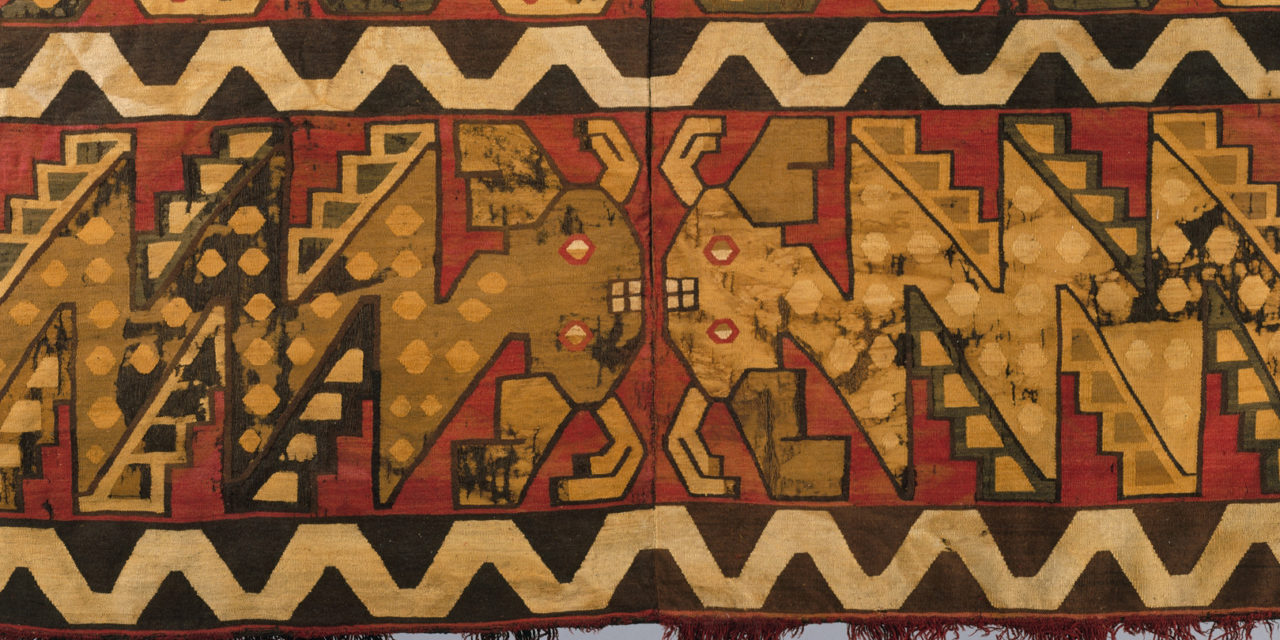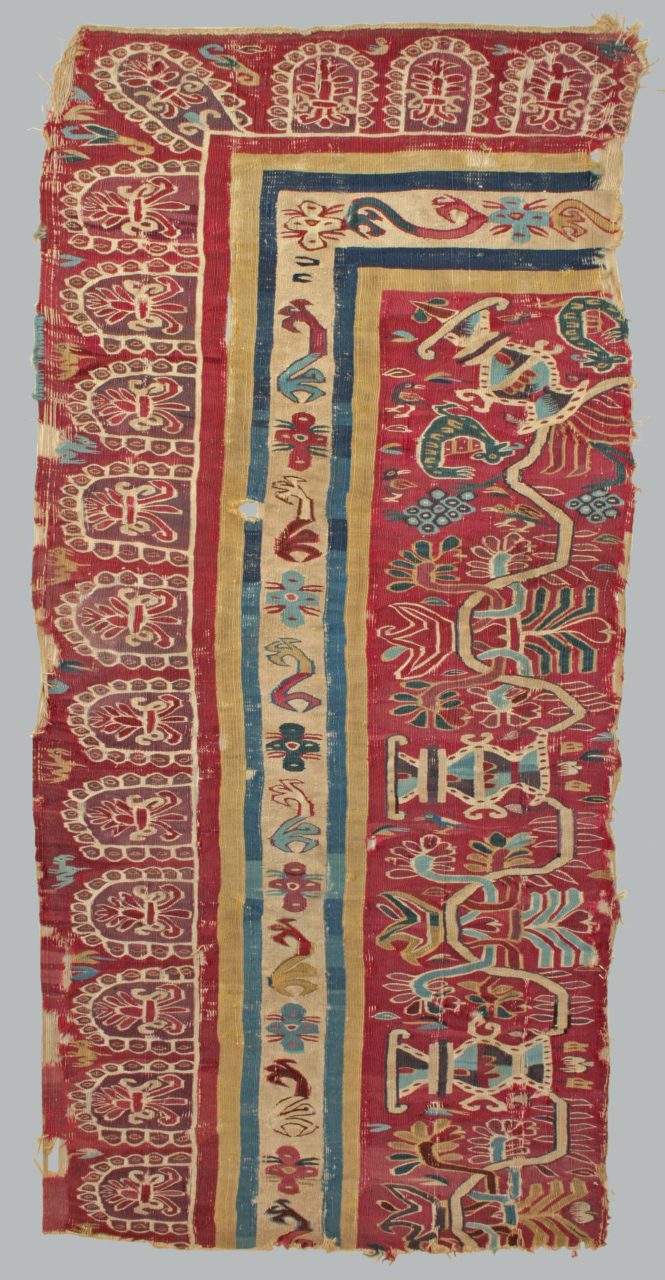Cochineal dyes come from the Cochineal beetle that is native to the Americas and is most commonly found on prickly pear cacti. When dried and crushed, it creates its famous red pigment that is used to dye textiles.
The Details
Regarding the process of creating cochineal dyes as well as its different properties, Karin Groen writes in an article on “Pigment” for Grove Art Online (2003):
“obtained from the dried female bodies of the cochineal shield-louse Dactylopius coccus Costa; it was imported into Europe after the conquest of Mexico in 1523. The colouring matter in cochineal is carminic acid (C 22 H 20 O 13 ), an anthraquinone dye.” (section 6, paragraph 5)
Figure 1 is a painted deer skin that displays pictorial narratives of history, marriages, and political and the military affairs of the Mixtec. The cochineal dye can be seen in the areas with vibrant red pigment.
Virginia Burnett writes similarly in an article on “Cochineal” for the Encyclopedia of Latin American History and Culture (2008):
“Cochineal (grana cochinilla), a bright red dye made from the bodies of small insects found on the nopal cactus. The production of cochineal dates to pre-Hispanic times. The Indians of southern Mexico and Guatemala traded cochineal extensively and used it as a dye for textiles. The process of extracting cochineal was extremely tedious and required great skill. It took approximately 25,000 live insects to make one pound of dye, and 70,000 dried ones to make the same amount.” (465)
Figure 2 shows a 16th-century Perivian tapestry thought to be a table/bed cover or an ordimental wall hanging. The red hues throughout its border and central motifs were created from cochineal dye.
Figure 3 is a Nasca-Wari tunic from ca. 800-850 with symmetrical catfish motifs, the use of cochineal dye can be seen in the red colored background.
Geoffrey Newman et al. give fascinating background on the American use of the cochineal insect in an article on “Colour” for Grove Art Online (2003):
“a brilliant red dye derived from the bodies of insects (Dactylopius coccus) which live on the paddles of the nopal cactus (Opuntia sp.). The cochineal insect is one of relatively few animals domesticated in the Americas. Because cochineal is more effective on animal fibers than on plant fibers, it was more widely used as a dye in the Andes, where camelid fibers were abundant, than in Mesoamerica, where cotton and maguey were among the primary fiber sources and cochineal was primarily used as an ink.” (section 6, paragraph 4)
Figure 4 shows a Mexican serape with diamond motifs in its center and an elaborate, colorful trim. Cochineal dyes can be seen in the red accents within the colorful patterns.
For more on cochineal and the history of red dyes, see the Timeline article, “The Red Craze.”
Fig. 1 - Artist unknown (Mixtec). Codex Zouche-Nuttall, 1200–1521 CE. Painted deer skin; 19 x 23.5 cm. London: British Museum, Am1902,0308.1. Ms. Curzon. Source: British Museum
Fig. 2 - Artist unknown (Peruvian). Hanging (?) Fragment, late 16th–17th century. Camelid hair, cotton; 121.9 x 58.4 cm (48 x 23 in). New York: The Metropolitan Museum of Art, 2011.324. Gift of Gloria Granz Gonick, 2011. Source: The Met
Fig. 3 - Artist unknown (Peru, Nasca-Wari). Tunic with Confronting Catfish, A.D. 800–850. Camelid hair, tapestry-weave; 54.6 × 109.9 cm. New York: The Metropolitan Museum of Art, 29.146.23. Gift of George D. Pratt, 1929. Source: The Met
Fig. 4 - Artist unknown (Mesoamerica, Saltillo). Saltillo serape, 1860–1900. Wool, cotton, metal; 219.7 x 114.3 cm. New York: The Metropolitan Museum of Art, 2002.471.2. Gift of Sally Hart Sheehy, 2002. Source: The Met
References:
- Garrard-Burnett, Virginia. “Cochineal.” In Encyclopedia of Latin American History and Culture, 2nd ed., edited by Jay Kinsbruner and Erick D. Langer, 465-466. Vol. 2. Detroit, MI: Charles Scribner’s Sons, 2008. Gale eBooks (accessed April 4, 2021). https://link.gale.com/apps/doc/CX3078901537/GVRL?u=fitsuny&sid=GVRL&xid=b0ff3790
- Groen, Karin. “Pigment.” Grove Art Online. 2003; Accessed 1 Mar. 2021. https://libproxy.fitsuny.edu:3117/groveart/view/10.1093/gao/9781884446054.001.0001/oao-9781884446054-e-7000067586
- Newman, Geoffrey, Amy McNair, B. N. Goswamy, Jonathan M. Bloom, Sheila S. Blair, Moyo Okediji, and Claudia Brittenham. “Colour.” Grove Art Online. 2003; Accessed 1 Mar. 2021. https://libproxy.fitsuny.edu:3117/groveart/view/10.1093/gao/9781884446054.001.0001/oao-9781884446054-e-7000018806














